Coherent vortex motion in superconductors
Grzegorz Jung
Superconducting quantum phase coherence gives rise to a variety of macroscopic quantum phenomena, among them to the Josephson effects. Due to extremely short coherence length, voltages appearing across high-TC superconducting microbridges are not related to Josephson effects but to the motion of current-created vortices. Josephson-like effects may however appear in relatively large high-TC bridges due to the coherence in current driven vortex flow. To enforce the coherent regime we employ laser written channels of easy vortex motion in c-axis oriented YBCO thin films, and heavy ion irradiated channels in BSCCO single crystals. The project is supported by the Israeli Science Foundation grant.
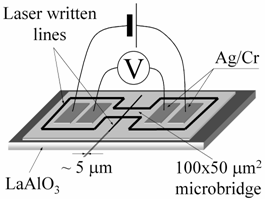 |
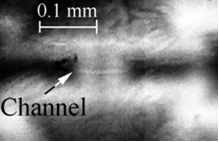 |
| Figure 1: Schematic of the layout of bridge with laser written channel for easy vortex motion. | Figure 2: Magneto-optical image of field penetration into a laser written channel in the bridge constriction. Bright areas mark high magnetic field. |
- Other active research projects, supported by four research grants, are opened for Ph.D. and M.S. students and include:
- Dynamics of vortices in spatially restricted superconductors (Grzegorz Jung)
- Anisotropy of flux-flow noise in vicinal YBCO thin films (Grzegorz Jung)
- Intrinsic tunneling in colossal magnetoresistive materials (CMR) (Grzegorz Jung, Vladimir Markovich)
- Metastable resistivity in CMR manganites (Grzegorz Jung, Gad Gorodetsky, Vladimir Markovich)
- Local magnetic properties of CMR manganites. (Grzegorz Jung, Gad Gorodetsky, Vladimir Markovich).
- Magnetic and transport noise in CMR manganites (Grzegorz Jung, Vladimir Markovich)
- Current noise in quantum wells. (Grzegorz Jung)
- Noise and plasmons enhanced charge separation in nanoparticles based devices. (Grzegorz Jung)
- Ferromagnetic resonance and phase separation in bulk and nano-scale CMR materials (Evgeny Rosenberg, Alexander Shames, Gad Gorodetsky, Grzegorz Jung)
- Transport, resonance and optical properties of carbon nanotubes filled with charge or magnetically ordered materials. (Evgeny Rosenberg, Grzegorz Jung)
Further details will be available soon at Prof. Jung's web site.
Subsurface STM imaging of electrically floating islands
Yishay Manassen
We are studying hydrogen absorption and corrosion on a metal surface. The system studied was Gd on W(110). This system was exposed to several Langmuirs of hydrogen. In the image below we see a series of consecutive images taken above the same place. The time between two images is about ½ hour. The phenomenon which is clearly distinguishable is the periodic appearance and disappearance of several islands. Since the islands appear and disappear exactly in the same shape, it clear that the island is not vanishing but somehow becomes transparent to the STM imaging process. As seen below, in some cases, the STM tip is imaging the surface under the island.
The process that is causing this phenomenon is the fact that hydrogen creates an insulating barrier between the Gd island and the W substrate. Thus the island is disconnected electrically from the substrate. As a result, the potential of the island is floating and when it is equal to the potential of the tip, the island is becoming part of the tip and the surface under the island is imaged.
The periodicity of the process is due to a competition between the stress induced by the hydride nuclei seen in the island as white protrusions and the stress in the insulating layer between the tungsten substrate and the gadolinium island.
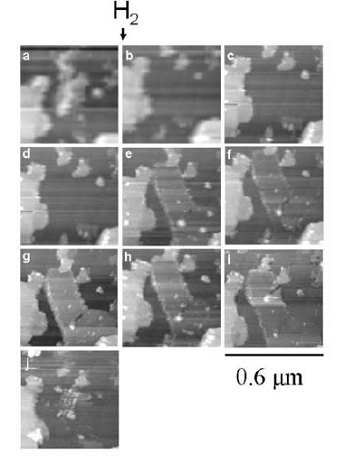
- Further reading:
- Surf. Sci. 600 2795 (2006).
Noise spectroscopy of a single spin
Yishay Manassen
We have found that tunneling with a STM (scanning tunneling microscope) to a surface in the neighborhood of a single paramagnetic atom or molecule (individual magnetic dipole) in the presence of an external magnetic field results in an elevated noise at the Larmor frequency. This high frequency noise results is due to the precession of a single magnetic dipole around the field (see Figure1).
The precession frequency depends strongly on the local environment of spin center, and can be used to identify molecules under the tip on the single molecule level. Fundamental information on the single spin physics is studied in this way. Additional potential applications are in single molecule data storage and quantum information.
Steps to improve the system which are implemented in these days, such as cooling to low temperature, working in time domain and scanning the field rather than the frequency are expected to improve the sensitivity of the detection system, to enable getting more information on the single spin physics.
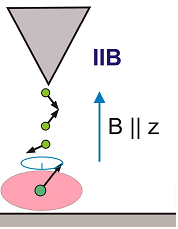 |
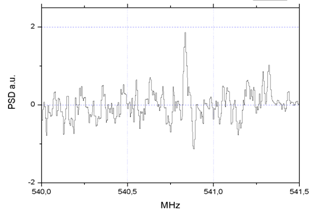 |
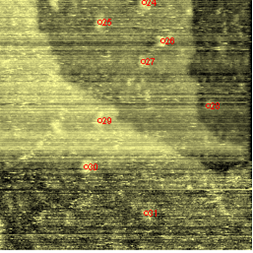 |
| Figure 1 | Figures 2,3: The image on the right is an image of a gold sample covered with DPPH molecule. The spectrum on the left is from the lowest molecule in the image (#31). We collaborate on this subject with a group from Italy and also with other groups around the world. | |
Further reading:
- J. Appl. Phys. 101, 053916 (2007)